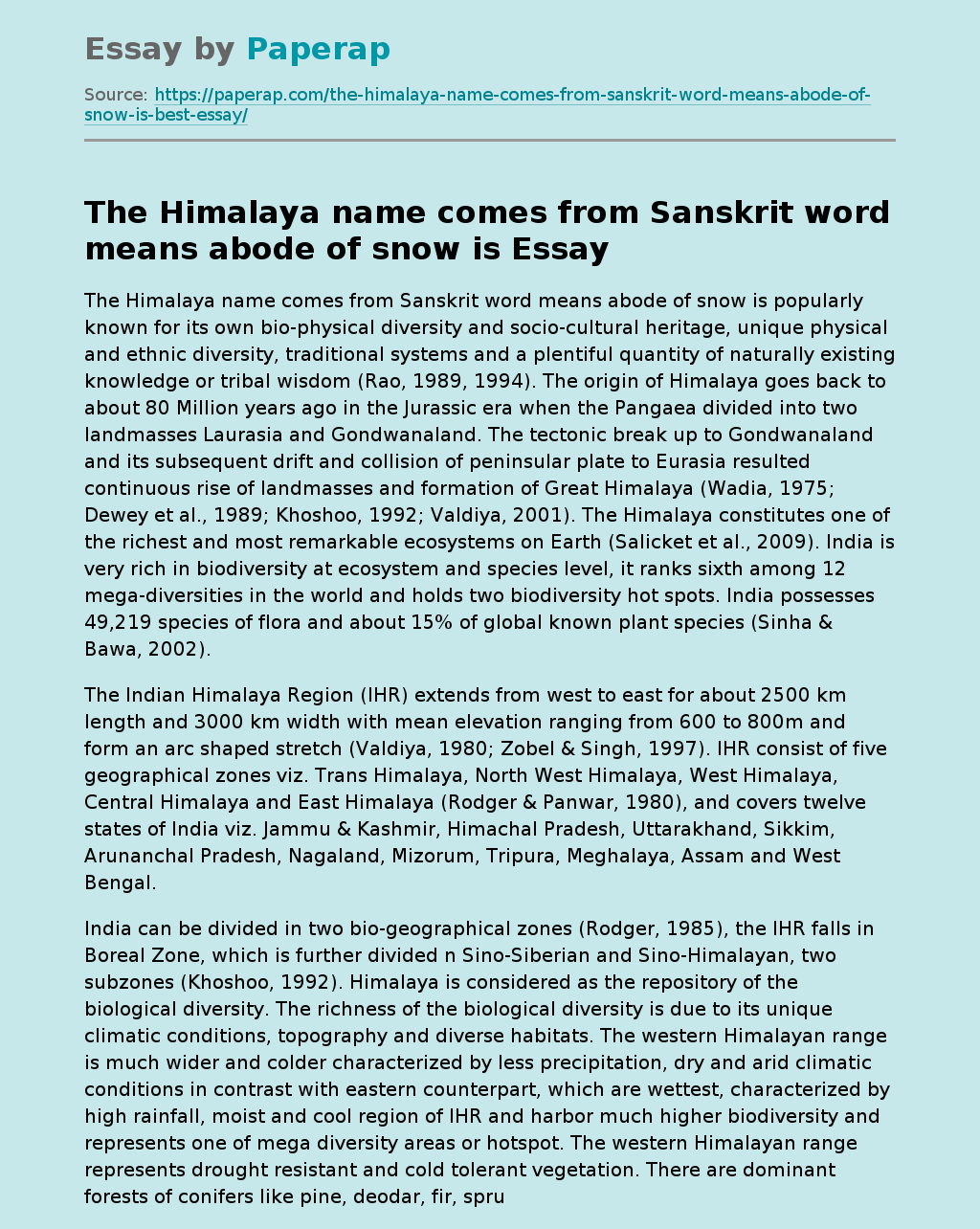The Himalaya name comes from Sanskrit word means abode of snow is
The Himalaya name comes from Sanskrit word means abode of snow is popularly known for its own bio-physical diversity and socio-cultural heritage, unique physical and ethnic diversity, traditional systems and a plentiful quantity of naturally existing knowledge or tribal wisdom (Rao, 1989, 1994). The origin of Himalaya goes back to about 80 Million years ago in the Jurassic era when the Pangaea divided into two landmasses Laurasia and Gondwanaland. The tectonic break up to Gondwanaland and its subsequent drift and collision of peninsular plate to Eurasia resulted continuous rise of landmasses and formation of Great Himalaya (Wadia, 1975; Dewey et al.
, 1989; Khoshoo, 1992; Valdiya, 2001). The Himalaya constitutes one of the richest and most remarkable ecosystems on Earth (Salicket et al., 2009). India is very rich in biodiversity at ecosystem and species level, it ranks sixth among 12 mega-diversities in the world and holds two biodiversity hot spots. India possesses 49,219 species of flora and about 15% of global known plant species (Sinha & Bawa, 2002).
The Indian Himalaya Region (IHR) extends from west to east for about 2500 km length and 3000 km width with mean elevation ranging from 600 to 800m and form an arc shaped stretch (Valdiya, 1980; Zobel & Singh, 1997).
IHR consist of five geographical zones viz. Trans Himalaya, North West Himalaya, West Himalaya, Central Himalaya and East Himalaya (Rodger & Panwar, 1980), and covers twelve states of India viz. Jammu & Kashmir, Himachal Pradesh, Uttarakhand, Sikkim, Arunanchal Pradesh, Nagaland, Mizorum, Tripura, Meghalaya, Assam and West Bengal.
India can be divided in two bio-geographical zones (Rodger, 1985), the IHR falls in Boreal Zone, which is further divided n Sino-Siberian and Sino-Himalayan, two subzones (Khoshoo, 1992).
Himalaya is considered as the repository of the biological diversity. The richness of the biological diversity is due to its unique climatic conditions, topography and diverse habitats. The western Himalayan range is much wider and colder characterized by less precipitation, dry and arid climatic conditions in contrast with eastern counterpart, which are wettest, characterized by high rainfall, moist and cool region of IHR and harbor much higher biodiversity and represents one of mega diversity areas or hotspot. The western Himalayan range represents drought resistant and cold tolerant vegetation. There are dominant forests of conifers like pine, deodar, fir, spruce and junipers. In contrast, eastern Himalayan dominated by broad leaf evergreen and semi deciduous woods, and reservoir of vast diversity. Thus on the basis of physiography and vegetation, Indian Himalaya can be divided in two major contrasting regions: Western Himalaya, from hills of North Bengal to Arunachal Pradesh. Apart from physical and geographical boundaries, Western Himalayan Region (WHR) represents six types of forests namely tropical deciduous forests, tropical pine forests. Himalayan moist temperate, Himalayan dry temperate, sub-alpine and alpine pastures/scrub. On the other hand Eastern Himalayan Region (EHR) represents five types of forest types viz. tropical evergreen, sub-tropical, temperate, alpine and stormy desert (Khoshoo, 1992).
Indian Himalayan Region represents tropical, subtropical, alpine, sub-alpine and xerophytic vegetation. The IHR harbours about 18440 species of plants, out of which 25.5% plant species are endemic to Himalaya (Singh & Hajra, 1996; Samant et al., 1998b). This region supports about 8,000 species of angiosperms (3200 species endemic), 44 species of gymnosperms (7 species endemic), 600 species of pteridophytes (150 species endemic), 1735 species of bryophytes (565 species endemic) (Singh & Hajra, 1996). Out of 7000 Indian endemic species, 3000 species found in Himalayan region (Chatterjee, 1939). A total of 1748 species of medicinal plants, 675 species of wild edibles, 279 species of fodder, 118 species of essential oil yielding and 155 species of sacred plants also occurs in this region (Samant et al., 1998, Samant & Palni, 2000; Samant & Pant, 2003). People living in Himalayan villages, utilize plants for medicine, food, fodder, fuel, timber, agricultural implements and many more other purposes (Samant & Dhar, 1997; Samant et al., 2007). Various human influence, non-sustainable utilization, habitat degradation, commercial exploitation, agricultural requirement, forest fire, and grazing pressures are the important sources of disturbances (Singh & Singh, 1992). Over exploitation of important plants in drugs and pharmaceutical industries led these floras toward extinction. 121 species have been recorded in the Red Data Book of Indian Plant (Nayar & Sastry, 1987, 1988 & 1990) and more than 70 species are under various threat categories. Therefore this has been necessitated assessing the status of vegetation, understanding the distribution patterns and diversity of vegetation of this region.
Along with floral diversity, IHR is also a house of unique fauna such as Snow Leopard, Red Panda, Himalayan Brown Bear, Himalayan Thar, Himalayan Musk Deer, Himalayan Ibex, Himalayan Lynx, Kashmir Stag, Yak, and the Himalayan Bearded Vulture, Pheasants, Monals, etc. Keeping in view the significance and values of biodiversity for the sustenance of inhabitants and its rapid loss from the natural habitats, Protected Area Network (PAN) has been established and most of the biodiversity rich areas have been notified as Biosphere Reserves, National Parks, and Wildlife Sanctuaries to conserve the ecosystems, habitats and species, respectively. At Present the IHR represents 5 designated Biosphere Reserves (BRs), 28 National Parks (NPs), and 98 Wildlife Sanctuaries (WLs) (Mathur et al., 2004; Rana & Samant, 2009) and a recently noted Cold Desert Biosphere Reserve (Samant et al., 2012).
Taxonomy is perhaps the oldest discipline of botany and above all most advanced as a subject. The science that deals with classification is called taxonomy, a term coined by famous French botanist A.P. de Candolle (1813). The literal meaning of the term taxonomy is lawful arrangement by rules of things (from Greek, taxis = arrangement; nomous = law, rule). Thus, plant taxonomy means classification of plants following certain rules or principles (Negi, 2010).
The Himalaya name comes from Sanskrit word means abode of snow is. (2019, Nov 30). Retrieved from https://paperap.com/the-himalaya-name-comes-from-sanskrit-word-means-abode-of-snow-is-best-essay/

